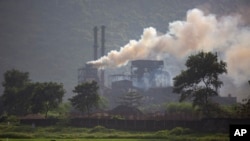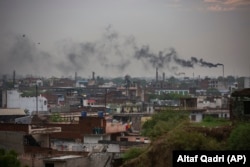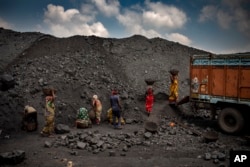A new estimate suggests India would need to spend about $900 billion to transition from coal to cleaner forms of energy.
The estimate was recently released by the New Delhi-based environmental policy group iFOREST.
iFOREST produced two reports that attempted to predict how much money it would take for India to move away from coal and other high-polluting fuels. The effort took into account the amount of money required to create new industry jobs for people employed at centers using coal and other fossil fuels.
Climate and energy experts have long sought to study ways to limit the economic harms of transitioning to cleaner energy fuels. Such considerations have been called “just transition.”
iFOREST head Chandra Bhushan told The Associated Press that just transition should be seen as a chance “for India to support green growth in the country’s fossil fuel dependent states and districts.
To get the $900 billion number, the group studied four coal districts in India and identified eight different cost elements. These included things like equipment, buildings and training for workers to transition jobs.
The reports suggest the biggest single investment to permit a just transition will be the cost of setting up clean energy infrastructure. That cost is estimated to be up to $472 billion by 2050. Getting workers new clean energy jobs will cost less than 10 percent of the total amount required, or about $9 billion.
iFOREST said $600 billion would come as investments in new industries and infrastructure. An additional $300 billion would come in the form of government assistance to support coal industry workers and affected communities.
Sandeep Pai is with the Center for Strategic and International Studies, a Washington D.C.-based policy group. He told the AP he thinks such a transition effort would be huge for India. He said the change could affect up to 20 million energy workers. “Reports like this are extremely important since the just transition conversation is beginning only now in India,” Pai said. “We need much more,” he added.
Studies have shown that India releases a large amount of planet-warming gases. Only China, the United States and the European Union release more. India depends on coal for 75 percent of its electricity needs and for 55 percent of its overall energy needs.
Earlier this month, the Indian government issued emergency orders requiring coal plants to run at full levels through this summer to avoid any power outages. Official numbers show the country’s coal use is expected to be at its highest between 2035 and 2040.
In 2021, Indian Prime Minister Narendra Modi announced the country had set a goal to reach net zero emissions by 2070. Net zero is when a country removes as many emissions as it produces.
United Nations Secretary-General António Guterres recently urged nations around the world to speed up their net zero goals. He called on developing countries to make 2050 their target year.
The recent reports say that the Indian government should first aim to close its old and unprofitable mines and power centers. Over 200 of India’s more than 459 mines can be closed in this way.
“The energy transition has to start with coal,” said Jayant Sinha, an Indian lawmaker who represents the coal-rich area of Hazaribagh in the central state of Jharkhand.
Sinha added that the move to clean energy needs both money and support from the government and environmental groups. “Both of this must happen together,” he said “for a successful transition.”
I’m Bryan Lynn.
The Associated Press reported this story. Bryan Lynn adapted the report for VOA Learning English.
_________________________________________________________
Words in This Story
transition – n. a change from one kind of thing to another
fossil fuels – n. fuels such as coal, oil, or natural gas that are formed in the Earth from dead plants or animals
district – n. a part of a city or country
infrastructure – n. the basic equipment and structures (such as roads and bridges) needed for a country or area to operate
conversation – n. a talk bewteen two or more people, usually informal
emission – n. the act of sending out gas, heat, light, etc.
______________________________________________________________
What do you think of this story? We want to hear from you. We have a new comment system. Here is how it works:
- Write your comment in the box.
- Under the box, you can see four images for social media accounts. They are for Disqus, Facebook, Twitter and Google.
- Click on one image and a box appears. Enter the login for your social media account. Or you may create one on the Disqus system. It is the blue circle with “D” on it. It is free.
Each time you return to comment on the Learning English site, you can use your account and see your comments and replies to them. Our comment policy is here.













Forum